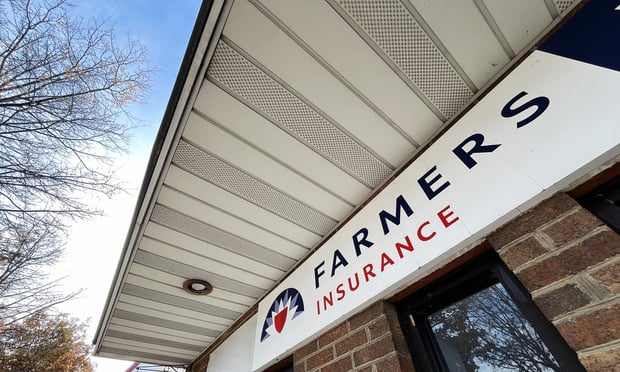Insurance bad faith exposure is always in the background of claims handling. This is never more true than in situations involving catastrophe claims. Handling these claims is different from handling other claims, however, and insurance bad faith law is one reason.
however, and insurance bad faith law is one reason.
There are causes of action or legal claims available under many statutes and at common law. The reference point for most jurisdictions is ordinarily a version of the National Association of Insurance Commissioners 1972 Model Act relating to unfair methods of competition and unfair and deceptive practices in the business of insurance. The following observations spring from experience with enactments of variations of that model act, from both Florida and other states. However, we will note that one of the major components of handling catastrophe insurance claims consists of partnering with people who know and understand local insurance law.
Liability Policies
Notice conditions apply to catastrophe claims. The real issue, however, is whether breach of a notice condition in a policy is the same as failure to perform a condition precedent to coverage.
The case law is in conflict. This is true under both liability insurance policies, which are designed to protect the policyholder and other insureds against claims and lawsuits based on the insured's asserted liability, and under the many forms of first-party insurance policies, which are designed to provide protection to the policyholder or other insured party.
Whether under third-party (liability) insurance policies or under first-party insurance policies, where notice is given but it is late, there are two views among the courts. Either there is a rebuttable presumption of prejudice to the insurance company in that situation, or proof of prejudice must be shown to the insurance company as a result of the allegedly late notice.
The governing standard in any jurisdiction comes from the same purpose of the notice provision, which is to permit the insurance company to investigate and evaluate the claim. This is true in all insurance claims and has a particular role in catastrophe claims separated between notice affecting liability and notice of things that affect the policyholder's claimed damages. Notice that impacts the insured's liability in a catastrophe claim is unlikely to affect the outcome. After all, in a catastrophe, almost all of the people in a given jury pool or on the bench will likely have heard of the catastrophe, even in places that are far away from where the catastrophe took place. Consider, for instance, the headlines that the Deepwater Horizon oil well platform explosion has generated throughout the world.
Notice that affects the particular insured's claimed damages, however, can be crucial in a catastrophe claim. The policyholder may present claims for insurance coverage—for example—payment of claimed damages, under forms of coverage that require notice to be given as soon as practicable. If the policyholder claims property damage following a hurricane, for example, then late notice can dramatically affect the condition of the property, and thus impact the outcome of the insurance company's ability to evaluate the extent of the particular policyholder's claimed loss. Property damaged by a typically covered peril such as wind, for example, may in the case of a particular property also be subject to damage caused by rain or flood, such as a house on which the roof lies open to the elements for some time after having been damaged by wind.
The cases in which notice is treated as a condition precedent most often involve situations in which the policyholder failed to comply with the notice provision in the policy. In such cases, courts appear to be more receptive to arguments that the insurance company was prejudiced by the policyholder's failure to comply with a notice provision. Confirming Coverage
After receiving notice of a claim, confirming coverage requires a working awareness of the insurance coverage law of the particular jurisdiction. In Florida, for example, an unfair claim settlement practices act has been made available for many years through Florida Statute Section 626.9541. In and of itself, Section 626.9541 provides no basis for a claim or cause of action. However, a violation of it is made actionable by Florida's so-called “Bad Faith Statute,” Section 624.155.
A major step in confirming coverage for a particular catastrophe insurance claim requires that we be aware of our need for resources and assistance, including coverage counsel in the particular jurisdiction from which the claim has come.
Under the case law, in general terms the process of confirming coverage includes examining all reasonably potential grounds for coverage, on the one hand, or risking exposure to penalties for unfair claim practices and exposure to extracontractual or “bad faith” liability, on the other hand. This has certainly held true in cases of Hurricane Katrina claims decided in Louisiana and Mississippi.
Determining the Cause of Loss
It is true in most (if not all) U.S. jurisdictions that the cause of loss is material to a determination of entitlement to recovery, including in catastrophe claims. In catastrophes, more so than in many other claims, experience and decided cases reflect that determining the cause of loss is made mostly by reliance on experts, such as engineers and architects, CPAs, and appraisers.
One thing not yet mentioned in the decided case law is the use of “comparables” to determine the cause of loss. It is predictable and, in my opinion, it is likely. “Comparables” is a term used here similarly to how a real estate broker or agent probably used the term when you may have bought a house, if you received a comparison to the value or supposed sales price of other houses in the same neighborhood so that you could make a better informed offer.
In determining the cause of loss in a catastrophe, insurance companies and their claims departments are likely to be asked to go beyond “vertical” comparables, which they already use. “Vertical” comparables refers to the policyholder's or other insured's own loss history from a given event. In contrast, “horizontal” comparables describes a comparison to other damaged persons or entities that may or may not also be insureds of your company, but may instead be insureds of other companies.
There is an argument that is perhaps unique to handling catastrophe claims, that failure to consider horizontal comparables, for example, failure to consider similar damages claims of similarly situated claimants, may in itself constitute “bad faith” and unfair dealing. This can potentially include failure to request, investigate or evaluate information obtained and payments made on such other similarly situated claims.
Privacy concerns have been raised and resolved in related areas, such as discovery in litigation. Rules of procedure and judicial administration already require lawyers and litigants to black out certain individually identifying information such as social security numbers in various matters. Florida Rule of Judicial Administration 2.420, which took effect on Oct. 1, 2010, is one example. Concerns about privacy in using horizontal comparables to investigate and evaluate damages in catastrophe claims may have already been answered as a result, before the questions can be raised. Good Faith, Bad Faith

Further, it has been held in a catastrophe case that it is not in and of itself “bad faith” for a property insurer to use a software program to evaluate damages.
Software is only a tool for keeping current, for updating the damages part of a catastrophe claim in this instance. Standing alone, it is neither “good faith” nor “bad faith.” It is essentially no faith at all. On the other hand, it is predicted and likely that the argument will be made in a future catastrophe claim that an insurer's failure to evaluate either liability or damages by using a software program can evidence bad faith and unfair dealing.
Catastrophe claims are almost always complex to the point of actually or nearly overwhelming any forensics investigation. Failure to investigate an insured's liability through a software program is an anticipated argument of bad faith and unfair dealing in handling catastrophe claims.
Finally, an insurance company often has the authority under the insurance contract to require the policyholder to submit to an examination or examinations under oath (EUOs). Requests for EUOs are often fully supported by the policy language and courts will ordinarily require insureds to submit to them in such cases absent evidence that the requests are being made unreasonably.
EUOs are not treated as depositions. Additionally, they are not ordinarily held subject to local rules of civil procedure or evidence, and the insurance contract dictates how often they may be requested. Although EUOs are most often associated with investigating the cause of a loss or helping to evaluate the insured's liability if any for the loss at issue, they are also extremely useful tools in evaluating damages, which is the third and final step in the usual adjustment process.
Requesting Documents
Depending on the language of the insurance policy at issue in a given claim, a proof of loss can be a “condition precedent” to the policyholder's claim. The insured is probably not going to be held to an obligation to provide a proof of loss if the insurer does not ask for one. There seems to be little excuse for not asking the insured for a proof of loss in every claim in which the policy authorizes the request.
The purpose of a proof of loss, which is recognized in the case law, is to allow the insurance company to receive sufficient information to determine policy rights and policy liabilities. If there is no proof of loss whatsoever, then there may be no claim whatsoever. In the total absence of a proof of loss, courts are far more receptive to the argument that the insurance company has an absolute defense to the claim.
If, on the other hand, the insured has made an effort to provide documentation and information in a proof of loss, then the courts will almost never find an absolute defense to a claim. This is particularly expected in the context of catastrophe claims, when it is highly unlikely that insureds will have all the documentation to support their claims. Many papers were swept away in Florida by Hurricane Charlie, for example, and Florida courts were aware of that fact. In such situations, the courts generally hold that “substantial compliance” determines the “sufficiency” of a proof of loss.
Whether a proof of loss is timely is generally a question of fact to be litigated, and timeliness in the decided cases involves the possibility once again of an “absolute defense” depending on what the insurer knew and when it knew it.
Providing Proof of Loss
The issue of substantial compliance concerning a proof of loss in catastrophe claims, in particular, arises when there is an asserted failure to provide all requested documentation allowed by the policy. The requests must be made to hold the insured to producing documentation deemed necessary by the insurance company, but the requests must be reasonable to meet the standards of good faith and fair dealing in most jurisdictions.
Partial proofs of loss are often the case in catastrophe claims. The requirements of good faith law, overdue payment statutes, as well as policy provisions, all come into play to some degree when the insurance company evaluates its coverage exposure in response to a partial proof of loss.
Good faith and fair dealing law in almost all jurisdictions can render the insurance company exposed to paying extra-contractual damages. That is, unless the insurance company pays the amounts clearly covered under its policy even if the proof of loss or other documentation received from the insured is incomplete.
Overdue payment penalty statutes in some states, such as Michigan, Wisconsin, and Florida, can impose statutory requirements so that insurance companies must pay clearly covered parts of partial proofs of loss or incompletely presented claims, regardless of whether failure to pay could give rise to a bad faith claim.
Policy provisions may require the insurer to pay covered items as a matter of contract, even if an insured's claim is not completely covered or even if it is not entirely clear what the total claim of an insured involves.
In conclusion, handling catastrophe claims to avoid bad faith exposure is not a great mystery. Catastrophe claims are not just bigger than other claims, but also present their own issues, and they are in fact too big and too complex for you to be expected to handle them alone. Seek the advice and counsel of people familiar with the insurance good faith laws in your jurisdiction. Handling catastrophe claims issues will determine whether your insurer is reasonably exposed to extracontractual damages including “overdue payments” penalties under statutes, and “bad faith” damages under the laws of the given jurisdiction, or whether you and your company demonstrated your actions in good faith claims handling.
Want to continue reading?
Become a Free PropertyCasualty360 Digital Reader
Your access to unlimited PropertyCasualty360 content isn’t changing.
Once you are an ALM digital member, you’ll receive:
- Breaking insurance news and analysis, on-site and via our newsletters and custom alerts
- Weekly Insurance Speak podcast featuring exclusive interviews with industry leaders
- Educational webcasts, white papers, and ebooks from industry thought leaders
- Critical converage of the employee benefits and financial advisory markets on our other ALM sites, BenefitsPRO and ThinkAdvisor
Already have an account? Sign In Now
© 2024 ALM Global, LLC, All Rights Reserved. Request academic re-use from www.copyright.com. All other uses, submit a request to [email protected]. For more information visit Asset & Logo Licensing.








